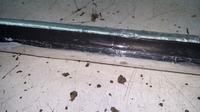abdoalghareeb
Member level 5

I try to build capacitance water level sensor.
It is 1 meter plastic tube (1 inch diameter), and two thin plates of aluminum covers the tube, the distance between plates are 1 cm.Then I Insulate the tube by adhesive tape.

That tube is the capacitor of 555 astable circuit.
the output frequency is measured by atmega16 to determined the tank water level.
The problem are:
The output frequency is not steady on any steady level (50cm level == 15.1 khz +- 0.3khz).
The length of wire between the tank and main circuit changes the frequency.
It is 1 meter plastic tube (1 inch diameter), and two thin plates of aluminum covers the tube, the distance between plates are 1 cm.Then I Insulate the tube by adhesive tape.

That tube is the capacitor of 555 astable circuit.
the output frequency is measured by atmega16 to determined the tank water level.
The problem are:
The output frequency is not steady on any steady level (50cm level == 15.1 khz +- 0.3khz).
The length of wire between the tank and main circuit changes the frequency.
Last edited by a moderator:


